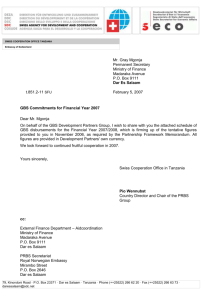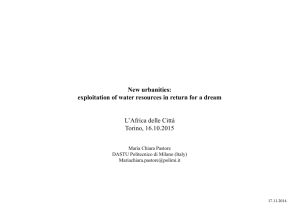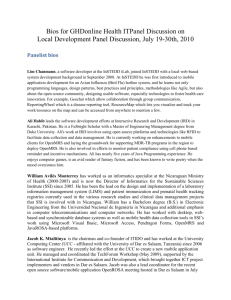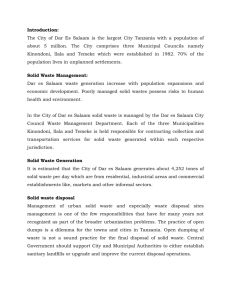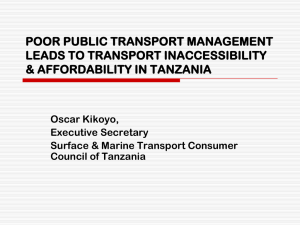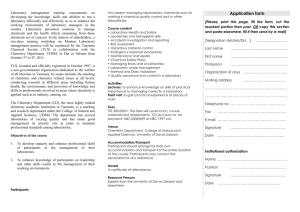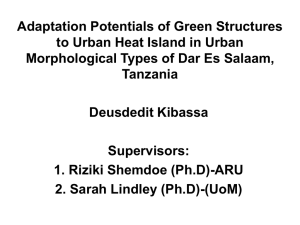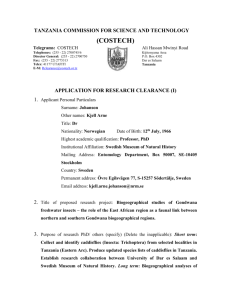Finished Pharmaceutical Products (FPPs)
advertisement
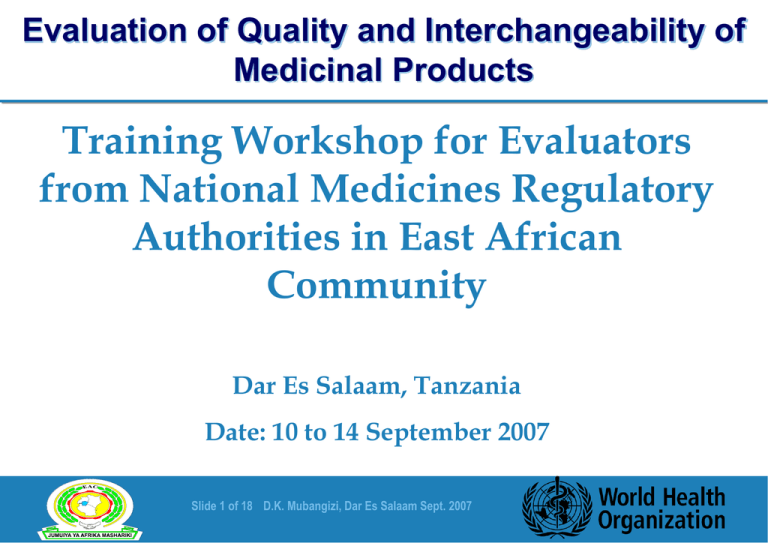
Evaluation of Quality and Interchangeability of Medicinal Products Training Workshop for Evaluators from National Medicines Regulatory Authorities in East African Community Dar Es Salaam, Tanzania Date: 10 to 14 September 2007 Slide 1 of 18 D.K. Mubangizi, Dar Es Salaam Sept. 2007 Evaluation of Quality and Interchangeability of Medicinal Products Finished Pharmaceutical Products Presenter: Formulation Control of FPP and method validation Container closure system Labelling SmPC and PIL Deus K. Mubangizi, pharmacist, MSc(Pharm.) deuskm@yahoo.co.uk, dmubangizi@nda.or.ug Chief Inspector of Drugs, National Drug Authority WHO expert Slide 2 of 18 D.K. Mubangizi, Dar Es Salaam Sept. 2007 Quality dossier / Section 3 Finished Pharmaceutical Product (FPP) 3.1. Manufacturing and marketing authorization 3.2. Pharmaceutical development 3.3. Formulation 3.4. Sites of manufacture 3.5. Manufacturing process 3.6. Manufacturing process controls of Critical steps and intermediates 3.7. Process validation and Evaluation 3.8. Specifications for excipients 3.9. Control of the FPP 3.10. Container/closure system (s) and other packaging 3.11. Stability testing Slide 3 of 18 D.K. Mubangizi, Dar Es Salaam Sept. 2007 Quality dossier / Section 3 Finished Pharmaceutical Product (FPP) 3.12. Container labelling 3.13. Product information for health professionals 3.14. Patient information and package leaflet 3.15. Justification for any differences to the product in the country countries issuing the submitted WHO-type certificate(s) Slide 4 of 18 D.K. Mubangizi, Dar Es Salaam Sept. 2007 or 3.3. Formulation Formula in tabulated form for : – – Administration unit (e.g. one tablet), Typical batch - Precise any overage, - Precise quantity adjustment of the API, - Precise q.s. for excipient. Excipients : – – – – – – State function (e.g. lubricant, disintegrant), Precise technical grade (e.g. micronised, purified water), Also those removed during process (e.g. water), Also those not always added (e.g. acid & alkali) : pH adjustment, Capsule shells, inked imprints on dosage form, Also gas (inert atmosphere). Slide 5 of 18 D.K. Mubangizi, Dar Es Salaam Sept. 2007 3.8. Specifications for excipients Microbiological limits for excipients of natural origin. Skip testing is acceptable, if justified. Excipients of human, animal or microbial origin: information regarding adventitious agents (e.g., sources specifications; description of the testing performed; viral safety data). Information on the avoidance and control of non-viral adventitious agents (e.g., transmissible spongiform encephalopathy agents (TSECEP is preferred), bacteria, mycoplasma, fungi). For oils of plant origin (e.g., soy bean oil, peanut oil) demonstrate the absence of aflatoxins or biocides. Only colours permitted by the EU’s “List of permitted food colors”, the FDA’s “Inactive ingredient guide” or “Japanese Pharmaceutical Excipients” may be used. Slide 6 of 18 D.K. Mubangizi, Dar Es Salaam Sept. 2007 3.8. Specifications for excipients Non-pharmacopoeial substances – – – – Details for manufacturing process, Specifications (description of procedures and acceptance criteria) Stability data Cross-reference to non-clinical (toxicological)- clinical data for safety aspects – Certificates of analyses of one batch of each excipient Pharmacopoeial excipients – Copy of the pharmacopoeial monograph used for control + certificates of analysis of one batch of each excipient – Provide details of any specifications additional to those in the pharmacopoeia Slide 7 of 18 D.K. Mubangizi, Dar Es Salaam Sept. 2007 3.9. Control of the FPP Reference – ICH Q6A — Specifications: Test Procedures and Acceptance Criteria for New Drug Substances and New Drug Products: Chemical Substances. Information on the reference standards or reference materials used for testing of the FPP should be submitted if not previously provided in API part. Slide 8 of 18 D.K. Mubangizi, Dar Es Salaam Sept. 2007 3.9. Control of the FPP 2 sets of specifications are possible: at release and at the end of shelf-life (list non exhaustive) Description of the FPP /appearance Identification of API Assay of API: ± 5% of the label claim at release and ±10% at the end of shelf-life purity tests [degradation products, residual solvents or other product (e.g. incompatibilities of APIs in a fixed-dose-combination (FDC) FPP] or process related impurities, microbial contamination); Pharmaceutical tests e.g. dissolution, disintegration (where applicable) Uniformity of dosage units (mass or content) Identification of colorants, identification and assay of anti-oxidants, chemical preservatives. The preservatives content limits of 90-110% at release are normally acceptable without further justification Slide 9 of 18 D.K. Mubangizi, Dar Es Salaam Sept. 2007 3.9. Control of the FPP physical tests appropriate to the dosage form, e.g. loss on drying, hardness, friability, particle size and apparent density; the identification tests for coloring materials used and identification and assay of antioxidants, antimicrobial or chemical preservatives with limits.. For FDC-FPPs, analytical methods that can distinguish each API in the presence of the other APIs should be developed and validated. Degradants in FDC-FPPs should be established with reference to the API they are derived from. If an impurity results from a chemical reaction between two or more APIs, then its acceptance limits should be calculated with reference to the worst case (API with the smaller area under the curve). Alternatively, the content of such impurities could be calculated in relation to their reference standards. Slide 10 of 18 D.K. Mubangizi, Dar Es Salaam Sept. 2007 3.9. Control of the FPP Microbial contamination. Sterility, bacterial endotoxins Monographs of Ph. Int., USP, BP are acceptable for the FPP + complementary tests If non-pharmacopoeial FPP, note for guidance Q6A applicable Description of all analytical procedures in details if not described in a pharmacopoeial monograph Validation of analytical methods and/or demonstration of applicability for pharmacopoeial methods Batch analyses for 3 lots with details of each lot (batch no, size, date of manufacture, use of batch) Slide 11 of 18 D.K. Mubangizi, Dar Es Salaam Sept. 2007 3.9.3 Validation of analytical procedures All non-compendial test procedures need to be validated. Results of the validation studies, comments on the choice of routine tests and standards must be provided. For pharmacopoeial methods, provide data to demonstrate that the method is applicable to this formulation. Reference(s) – WHO Guideline: Validation of analytical procedures used in the examination of pharmaceutical materials. – ICH-Q2A Text on Validation of Analytical Procedures http://www.ich.org/MediaServer.jser?@_ID=417&@_MODE=GLB – ICH-Q2B Validation of Analytical Procedures: Methodology http://www.ich.org/MediaServer.jser?@_ID=418&@_MODE=GLB Slide 12 of 18 D.K. Mubangizi, Dar Es Salaam Sept. 2007 3.10. Container-closure system Discussion on the choice of container Choice of the material Protection against light and humidity compatibility/interaction of materials in contact with dosage form Safety of materials used Detailed description of the container Specifications of the container with dimensions and drawings Specifications of materials in contact with FPP Composition of these materials, compliance with pharmacopoeia Identification of components e.g. IR for plastic materials Description of the secondary packaging Slide 13 of 18 D.K. Mubangizi, Dar Es Salaam Sept. 2007 3.12. Container labelling Outer packaging : Where no outer packaging, on immediate packaging, e.g. HDPE bottle. – – – – – – – – – – – Labelling should include at least the following : The name of the FPP. Method of administration. A list of API(s) (using INNs if applicable) showing the amount of each present in a dosage unit, and a statement of the container, e.g. number of dosage units, weight or volume. List of excipients known to be a safety concern for some patients, e.g. lactose, gluten, metabisulfites, parabens, ethanol, or tartrazine. Instruction on use. The batch number assigned by the manufacturer. The expiry date in an uncoded form. Storage conditions or handling precautions that may be necessary. Directions for use, and any warnings or precautions that may be necessary. The name and address of the manufacturer, company or person responsible for placing the product on the market. Slide 14 of 18 D.K. Mubangizi, Dar Es Salaam Sept. 2007 3.12. Container labelling Blisters and strips should include, as a minimum, the following information – – – – Name, strength and pharmaceutical form of the FPP Name of the manufacturer, company or person responsible for placing the product on the market The batch number assigned by the manufacturer The expiry date in an uncoded form Slide 15 of 18 D.K. Mubangizi, Dar Es Salaam Sept. 2007 3.13. Product information for Health Professionals Summary of product characteristics (SmPC) – – – Aimed at medical practitioners and health professionals Changes to SmPC to be approved by WHO See Annex 5 of the main generic guide Slide 16 of 18 D.K. Mubangizi, Dar Es Salaam Sept. 2007 3.14. Patient information and package leaflet Copy of the patient information leaflet (PIL) In conformance with SmPC See Annex 6 of the main Generic guide Slide 17 of 18 D.K. Mubangizi, Dar Es Salaam Sept. 2007 THANK YOU Slide 18 of 18 D.K. Mubangizi, Dar Es Salaam Sept. 2007
